Sunday, December 09, 2007
Delay, Again
We could have been airborne by now, but for one more snag. Yellowbird's IFR inspection was due last month. This inspection, which must be done every 24 months, is required for all aircraft certified for operations in instrument meteorological conditions and involves checking the altimeter and static system. Also due was the transponder inspection, which is required for all aircraft equipped with a transponder. Some of the components involved are interconnected, so it makes sense to do both inspections at the same time.
The typical encoder contains the inner workings of an altimeter, minus the dial and needle. Instead of a visual display, the altitude is encoded into a digital format which is fed to the transponder. When the transponder receives a signal from an air traffic control radar station, it replies with the encoded altitude and the four digit "squawk" code dialed into the transponder, thus providing air traffic controllers with a means of identifying specific aircraft operating at specific altitudes.
Our last IFR check was done two years ago, and concluded several months of troubleshooting various problems with the transponder. These included incorrect altitude readouts and squawk codes, and forced the cancellation of one IFR lesson when the approach controller, weary of the mixed signals we were sending hem, told us to land and not clutter his airspace again until we got our transponder fixed. The problems were eventually traced to a bad connection in the wiring harness between the encoder to the transponder, and the transponder itself, which was eventually replaced.
I wasn't expecting any problems with this year's inspection, but in light of the past five months, I should be used to disappointment. The local avionics shop began the inspection and discovered that the altitude encoder was dead.
In another case of "I wish I had taken a picture…", I wish I had taken a picture of the old encoder before it was removed. It looked just like an altimeter, except that it had no face. It was designed to fit in the instrument panel like any other instrument, but with a blank plate where the gauge would normally be visible. Yellowbird was born with a full panel so the encoder was screwed to the side of the heater duct under the panel and just above the rudder pedals.
The old encoder could have possibly been repaired, but as is often the case with old electrical equipment, the repairmen who are aged enough to remember the old ways would have to be dragged out of retirement, so it was cheaper to replace it with something more current. Thus, we'll be getting a new "solid state" encoder, perhaps connected to the new transponder by a wiring harness made of that new fangled "metal" that the young kids are talking about these days.
This is all going to take another week or so to get resolved, but after being grounded for over four months, what's another week or two? At least the engine is all set. Here are some more pictures:
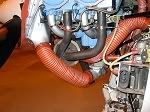 The carburetor intake duct in place, leading from the air intake in the forward baffle to the carb heat airbox below the carburetor. The old intake duct was a bit too long and tended to chafe against the inside of the lower cowl. I cut the replacement a bit shorter to prevent a recurrence.
The carburetor intake duct in place, leading from the air intake in the forward baffle to the carb heat airbox below the carburetor. The old intake duct was a bit too long and tended to chafe against the inside of the lower cowl. I cut the replacement a bit shorter to prevent a recurrence.
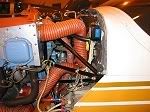 The back of the engine with all the ducts and wires connected.
The back of the engine with all the ducts and wires connected.
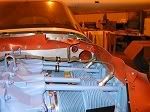 Above the cylinders. The ignition harness is tied up with cable ties and secured to a pushrod tube with a couple of Adel clamps. The intakes for the cabin fresh air and fuel strainer vent are visible in the rear baffle.
Above the cylinders. The ignition harness is tied up with cable ties and secured to a pushrod tube with a couple of Adel clamps. The intakes for the cabin fresh air and fuel strainer vent are visible in the rear baffle.
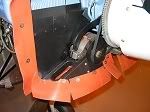 The alternator fully installed, adjusted, and secured with a twist of safety wire. The forward baffle had been bent and required some repair, including a doubler patch near the top and a standoff bracket to prevent the baffle from chafing against the alternator fan. A sliver of dark gray baffle seal at the top prevents the baffle from chafing against the propeller oil line.
The alternator fully installed, adjusted, and secured with a twist of safety wire. The forward baffle had been bent and required some repair, including a doubler patch near the top and a standoff bracket to prevent the baffle from chafing against the alternator fan. A sliver of dark gray baffle seal at the top prevents the baffle from chafing against the propeller oil line.
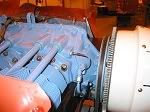 A good shot of the alternator belt wrapping around the starter ring. One drawback to this setup is that you have to remove the propeller to change the alternator belt. I had them put on a fresh belt, didn't I? The JPI oil temperature sensor is secured with a twist of safety wire around the propeller oil line fitting.
A good shot of the alternator belt wrapping around the starter ring. One drawback to this setup is that you have to remove the propeller to change the alternator belt. I had them put on a fresh belt, didn't I? The JPI oil temperature sensor is secured with a twist of safety wire around the propeller oil line fitting.
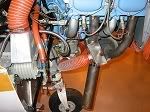 Why yes, that is a very shiny carb heat shroud - thanks for noticing!
Why yes, that is a very shiny carb heat shroud - thanks for noticing!
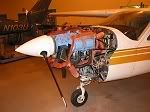 She has her nose back! And in another week or so, I hope to have my airplane back...
She has her nose back! And in another week or so, I hope to have my airplane back...

Scott, Yellowbird is looking very nice. You must be very anxious to return her to the air.